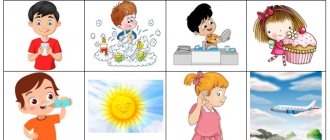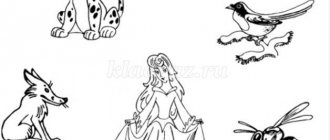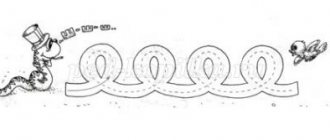Differentiation of sounds [h]-[t], [h]-[ts], [h]-[sch]
The easiest, but at the same time effective exercise.
Pronounce the following syllables in turn:
| tsa-cha-sha-ta | tso - what - what - that | tsu - chu - schu - tu |
| tsy - chi - cabbage soup - ti | tse -che - more - those | sha - cha - tsa - ta |
| what - what - so - then | schu - chu - tsu - tu | cabbage soup - chi - tsy - you |
| shche-che-tse-those | ats - ach - ash - at | ots - och - oshch - from |
| uts - uch - ush - ut | yats - yach - box - yat | its - ich - isch - it |
| ec - ech - yet - et | ash - ach - ats - at | oshch - och - ots - from |
| ush - uch - uts - ut | box - yach - yats - yat | isch -ich -its -it |
| yet - ech - ec - ut |
One hundred thousand why
Close
Pronouncing the sound “Ch” often causes difficulties for children. To teach a child to pronounce it, you need to go through several stages.
Preparatory work
Work on any sound should begin with articulatory gymnastics. This will allow you to warm up and get ready for work. For warming up, you can choose any gaming technique. Let's consider just a few options.
1. “Swing”: this exercise helps strengthen the muscles of the tongue and teach the child to control the tip of the tongue. The mouth is open, the lips are in a smile. The child alternately touches the top and bottom of the mouth with his tongue, then the upper and lower teeth, the place behind the upper and lower teeth.
2. “The tongue walks through the teeth” The mouth is open, the lips are in a smile. The child touches the outer and inner surfaces of the upper and lower teeth with his tongue.
You can also ask your child to clap his hands when he hears the sound “Ch.” Then you should first pronounce simply different sounds, then syllables and words. This technique will allow you to evaluate how well the baby recognizes the desired sound. If a child has better developed visual thinking, instead of words, offer him pictures with “H” in the name.
Breathing exercises
Setting the sound "Ch"
The sound “CH” consists of the sounds “Ш” and “Ть”. This means that a child who correctly pronounces the last two sounds will easily cope with pronouncing “Ch”. There are two ways to produce this sound.
1. The child must very quickly pronounce the combination of sounds “TH” and “SH”. It is very important that the lips are in a wide smile. 2. The child pronounces the sound “TH” very quickly, repeating it. First, the tongue should touch the base of the teeth from the inside, then you should gradually move it a little deeper, towards the alveoli. If you can’t learn to pronounce “Ch”, you can contact a speech therapist who will make the sound using a special probe.
To make sure that the sound is delivered, you should check how the child pronounces it in isolation. Game techniques are also used for this: the baby can be asked to imitate the passage of a clock using the sound “Ch” or to calm someone down (“Ch-Ch-Ch”). If everything is in order, you can start automation.
Automation of the sound "Ch"
Automation should be carried out taking into account the age of the child. With a baby, it is best to use pictures or toys; with older children, rhymes and songs are perfect. You should start by pronouncing syllables, and then gradually move on to words and sentences. In this case, you need to select such material so that the sound “Ch” appears in different positions. In any case, automation should take place in a playful way. There are a variety of games you can use.
1. “Songs with your favorite character.” It is necessary to choose any fairy-tale or cartoon character that is interesting to the child, and write on the cards the syllables containing the letter “H”. Then you need to offer the following task: “Your favorite hero decided to help you learn to pronounce “Ch” and prepared songs for you from the syllables. Sing along with him! Cha-cha-cha; Cho-cho-cho; Chu-chu-chu; Chi-chi-chi." It is very important that the child pronounces the “Ch” sound in a syllable correctly; only in this case can one move on to the next syllable. 2. "Echo". The child must repeat several words spoken by an adult in the same order, emphasizing the “Ch” sound. 3. "Offer". For this exercise, you can write a few words with the letter “C” on paper or use pictures. The child’s task is to make a sentence with each of them. 4. "Cubs" It should be suggested to name the cubs of various animals and birds (squirrels, hares, jackdaws, wolves), emphasizing the sound “Ch”. 5. "Confusion." The child is offered sets of letters from one word in a mixed order. His task is to collect the word and pronounce it.
Staging and automation of the sound “Ш”
Share on social media networks
I like
Related posts:
Exercises to develop exhalation
- The baby stands with his feet shoulder-width apart. While inhaling, he spreads his arms with his nose, while exhaling, he squats and hugs himself with his arms.
- Starting position is the same as in the previous exercise. Connect your hands in a “lock”, they are at the bottom. As you inhale, your arms rise up, while your breath is held. Then exhale very slowly, lowering your hands and saying “uh.”
- Puff out your cheeks to the maximum, hold for half a minute. Then pull your cheeks in and hold again for the same amount of time.
- Sit on a chair. Slowly lower and raise your hands, saying “Kaar”.
- Game-competition. Children compete to see who can growl the longest in one breath. (You can also compete to see who can hum the longest while exhaling.)
Setting the sound Ch
Goal: to teach the child to pronounce the standardized sound h .
Equipment: diagram of the structure of the articulatory apparatus when pronouncing the sound h; probe, spatula; pictures-symbols, subject pictures.
Staging sound in various ways.
1. By imitation:
- the child is offered a sample of sound pronunciation in combination with play images (the chirping of a grasshopper, etc.); At the same time, visual control of correct articulation and tactile (tactile) sensations are used.
2. From the merger of the constituent parts of the affricate h:
— the child is asked to pronounce the sounds t', sch as he exhales: first slowly, then quickly and sharply (in unison).
3. From reference sound:
- the child is asked to pronounce the syllable, paying attention to the connection of the tongue with the alveoli, gradually moving the tongue back; You can additionally imitate the movement of the tongue with your hands.
4. From reference sound with mechanical assistance:
— the child is asked to pronounce the sound/syllable th/at, paying attention to the connection of the tongue with the alveoli, gradually moving the tongue back with a spatula placed over the tongue;
- the child is asked to pronounce the sound, at the same time lightly press his fingers on the corners of his mouth and stretch his lips forward - “with a mouthpiece”: the tip of the tongue moves back, the sound h is heard.
Correction of violations of the pronunciation of the sound /Ch/
The child is asked to raise the tip of the tongue to the “tubercles” behind the upper teeth and pronounce the combination “at.” At the same time, the speech therapist, pressing his fingers on the corners of the child’s lips, pushes them forward. It turns out “ach”.
Lip exercises
- “Grimaces of a Clown.” Keep your lips smiling. In this case, the lips should be tense, and the teeth should not be visible. The duration of the exercise is 15 seconds.
- “Fence.” Smile again, but at the same time close your teeth and expose them. Hold the position for 10 seconds.
- “Tube”. Pull your lips into a tube and hold for a third of a minute. The teeth don't connect.
- "Bagel". Round your lips and pull them forward slightly. Hold in position for 15 seconds.
To achieve good articulation, exercises need to be alternated, changing the sequence each time.
Tongue exercises
Language exercises are divided into static and dynamic.
Static complex:
- "Spatula". Relax your tongue and place it on your lower lip. Stay in this position for 10 seconds (the edge of the tongue should touch the corners of the lips).
- “The point of a needle.” Remove the tongue from the mouth, straighten and tense - the tongue at this time should be even and narrow.
- “Angry cat.” Place the tip of your tongue against your lower teeth and touch the middle of your tongue to your upper palate. Stay in the position for half a minute.
Explanatory and other types of speech as the level of development of a preschooler
Dynamic complex:
- “Punishment for the tongue.” Stick out your tongue and place it on your lower lip. Press your tongue with your lips and say five-five-five.
- “Watch.” Stick out your tongue and stretch it to one ear, then to the other. Keep the entire speech apparatus in tension.
- “Swing”. Stick out your tongue and pull it alternately towards your nose and chin.
- "Horse". Click your tongue, imitating the blows of a horseshoe. The middle of the tongue is always pressed to the palate.
- "Little Turkeys" Run your tongue back and forth across your upper lip so that you make the sound bl-bl. The speed of movement gradually increases.
The age of the child and the readiness of his speech apparatus
Schematically, a child’s speech development can be divided into stages.
Stage 1. Preparatory
The baby's age is up to 1 year. At this time, an important moment in the baby's development is humming and babbling. At first, sounds appear involuntarily, and by 5 months the child learns to imitate and respond to adults.
Stage 2. Pre-school
Lasts from 1 to 3 years. During this period, children begin to speak in monosyllabic phrases (instead of “Grandma, go,” they say “Baba, di”). Until the age of two, the vocabulary of objects and verbs increases (up to 24 months, the vocabulary is 90-100 words).
After two years, work begins on the quality of speech, and a clear pronunciation of most sounds is formed.
In the pre-preschool period, parents should contact a speech therapist if the child does not put words into short sentences.
Stage 3. Preschool
Lasts up to 7 years. By this age, the child’s active vocabulary includes 3000 words. At 3-4 years old, the baby can still replace some sounds (ts, ch with t), soften consonant sounds.
By the age of 5, softening should pass, whistling and hissing sounds are formed.
By the age of 6, the child learns to pronounce the sounds R and L, and complex, well-constructed sentences appear in speech.
Stage 4
At 7 years old, a child’s speech should be a full-fledged means of communication. Children not only pronounce all speech sounds correctly, but also distinguish them by ear and know how to analyze them. Conjunctions and allied words appear in speech; there are practically no errors in pronunciation. After several comments, the child analyzes the speech and corrects mistakes.
5th period. School
Lasts from 7 to 17 years. At this time, speech, both oral and written, is brought to perfection. The age period from 7 to 9 years is considered critical. This is explained by the fact that after 9 years of age, a child who has no experience of verbal communication becomes unable to learn.
By the age of 11, all phonetic errors in pronunciation disappear.






